Continuity During the 1800s to 1900s
American History Timeline 1800-1900
1800 – Washington D.C. becomes the capital of USA
In the 1780s, it was decided that the capital of the newly-born USA will eventually be moved to a new city. From 1790 onwards, work began to construct new buildings at the site of the Washington D.C. city. In 1800, President John Adams took up his seat at the White House in Washington D.C. At the same time, Washington also became the new capital of USA.
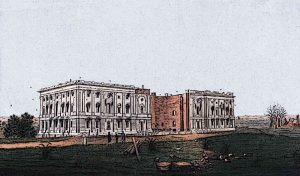
1800 Washington D.C. becomes the capital of USA The white House Construction
1800 – Library of Congress is established
In 1800, the parliament and government buildings were being moved to the new capital of Washington D.C. At the same time, Congress decided to establish a library as well. A new legislation was approved by President John Adams which set aside a sum of $5000 to purchase the books for the establishment of the library. Today, the library is one of the largest and most prestigious libraries in the world.
1801 – Thomas Jefferson becomes the 3rd President of USA
Thomas Jefferson was one of the most famous Founding Fathers of USA. He was the author of the Declaration of Independence which first spoke of an independent country for the American states. In 1801, Thomas Jefferson became the 3rd President of United States. He was a staunch support of democracy and took many steps to strengthen it during his time as president.
1803 – Louisiana Purchase doubles the size of USA
The Louisiana Territory was a large piece of land in the centre of modern-day USA. It stretched from the Mississippi River in the east to the Rocky Mountains in the west and from the Canadian border in the north all the way to the Gulf of Mexico. The USA originally wanted to buy the New Orleans port located at the mouth of the Mississippi River on the Gulf of Mexico.
The port was under the control of the French who also owned the Louisiana Territory. After multiple rounds of negotiations, France agreed to sell not just the port but the entire Territory. USA paid $15 million as a part of the deal. With the new Louisiana Territory, the overall size of USA effectively doubled.
1804 – The Lewis and Clark Expedition begins
Although USA had purchase the Louisiana Territory, no one knew how the land was or if there were any roads or other infrastructure. So President Thomas Jefferson decided to send an expedition into the lands west of the Mississippi river.
This expedition became known as Lewis and Clark Expedition. It was so named because it was led by Captain Meriwether Lewis and Lieutenant William Clark. The expedition would take more than a year to complete.
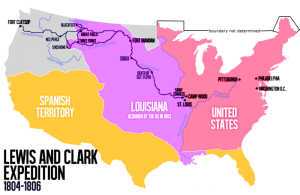
Lewis and Clark Expedition Map
1812 – War of 1812 starts
In 1812, Britain was fighting a war with the French Empire. The British Royal Navy blockaded France to stop it from trading with other countries, including America. This angered some people in USA.
The Royal Navy also captured a number of American vessels and seaman. These were then put to the war effort against France. Reacting to these actions, USA declared war on Britain in 1812. This became known as the War of 1812. Some of the members of Congress in USA actually hoped to add the Canadian territories to the USA through this war, but this objective failed.
1812 – Louisiana becomes the 18th state of USA
Since the Louisiana Purchase, the population of the Louisiana Territory had rapidly increased as more and more settlers from the eastern states went there.
By 1812, the population was large enough so that a new state was established west of the Mississippi River. This became known as the state of Louisiana. It became the first state to be established west of the Mississippi River and became the original boundaries of the USA.
1813 – Battle of Thames is fought
The War of 1812 was still ongoing in 1813. The Battle of Thames was fought in Chatham, Ontario. It was fought between American troops and an alliance of British and Indian forces. The Indian tribes were organized under the famous Native American leader Tecumseh. American forces gained a decisive victory in the battle and Tecumseh was killed.
1814 – Treaty of Ghent is signed
By 1814, the war between France and Britain had ended. The War of 1812 still continued between USA and Britain. But both side realized that the war was no use as both sides failed to make any important gains.
So negotiations began and a peace treaty was signed. This effectively brought the war to an end. The peace treaty was known as the Treaty of Ghent. According to the treaty, both sides returned the lands they had occupied during the war, with small exceptions.
1815 – Battle of New Orleans takes place
The Treaty of Ghent was signed in December, 1814. It was signed in Netherlands and news of the treaty had not yet reached the United States in January 1815. So the British and American forces continued fighting.
The Battle of New Orleans took place on January 8, 1815. Major General Andrew Jackson, was later became the U.S. President, led the American troops. The battle resulted in a decisive American victory with heavy losses on the British side.
1817 – Era of Good Feelings begins
In 1817, James Monroe became the U.S. President. Monroe sought national unity by combining different political factions. The era also saw the ends of European wars, which allowed the USA to foster trade ties with the European nations. Americans enjoyed peace, prosperity and a sense of national unity during this era.
1816 – Indiana becomes the 19th state of USA
American settlers had been settling in the lands of modern-day Indiana by the early 19th century. This led to many conflicts with the local Native American tribes. After many battles, the American forces stood victorious and white settlers became secure in their land ownership. This finally led to the establishment of the state of Indiana in 1816. It effectively became the 19th state of USA.
1819 – Economic crisis known as 'Panic of 1819' occurs
The Panic of 1819 was a widespread economic crisis that hit USA in 1819. During the previous decade or so, many Americans had gone into the west, settled, built farms and houses and started businesses. They took loans from state banks but were unable to repay these loans later. This, and many other factors, contributed to the Panic of 1819. The economic crisis continued until 1821 although the American economy didn't fully recover until 1824.
1819 – Missouri Compromise is reached
By 1819, USA had 22 states. These include 11 free and 11 slave states. There was bitter rivalry in the Congress between the pro-slavery and anti-slavery factions. In 1819, Missouri sought to be admitted as a new state. It was a slave state, so admitting it would have given slave states a majority in the Congress.
To avoid disturbing the balance between pro-slavery and anti-slavery states, the Missouri Compromise was reached. According to this compromise, Missouri was admitted as a slave state. At the same time, Maine was admitted to the union as a free state.
1823 – The Monroe Doctrine is put forward as an official US policy
In 1823, President James Monroe announced a new policy. According to this policy, European colonial powers were barred from colonizing any part of the American continent in the future.
The policy aimed to put an end to the European ambitions in Central and Latin America. The policy was announced at a time when several nations in the Latin America were fighting for independence from Spanish rule.
The policy became known as the Monroe Doctrine and it would become the basis for the American intervention in different parts of Central and Latin America against the European powers.
1828 – Andrew Jackson becomes the U.S. President
In 1828, Andrew Jackson was elected the 7th President of the United States. His presidency marked the rebirth of the Democratic Party in American politics. During his term, Jackson played a major role in relocating the Native Indian tribes living east of the Mississippi river. This relocation eventually became known as the Trail of Tears.
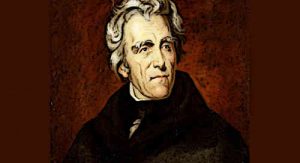
Andrew Jackson President Of America Portrait Image
1830 – The Oregon Trail is established
In the 1830, American settlers started traveling to the Oregon Territory. This was a very long journey and the route that was popularly used for making the journey famously became known as the Oregon Trail. The trail was first followed and established by settlers in 1830. It ran for around 2,000 miles, starting in Missouri and culminating in Oregon.
1830 – Indian Removal Act is passed
In 1830, the Indian Removal Act was signed into law by President Andrew Jackson. This law gave him the power to relocate Indian tribes living east of Mississippi river to the western territories.
Although the law said that the relocation would be arranged through negotiation, many Native American tribes were ultimately forcibly removed and marched to new territories. Thousands died along the way.
1832 – Black Hawk War takes place
By 1832, large numbers of American settlers were arriving in Illinois. The Native Americans who lived in the area resented them because they took their lands.
Sauk Native Americans under Black Hawk attacked the settlers and fought them. Then in 1832, a U.S. army arrived in the area and this led to a war between the two sides. The war lasted for 15 weeks. It resulted in the defeat of the Sauk warriors and Black Hawk was taken prisoner.
1835 – Texas Revolution begins
In 1835, Texas was still a part of Mexico. Mexico, which had previously been ruled by Spain, was now an independent nation under the dictatorship of General Lopez de Santa Anna. Although the American settlers in Texas were relatively independent, Santa Anna now wanted to impose his control over them. This led to a conflict.
In 1835, a hundred Mexican soldiers marched to Texas to get back a cannon which had been sent from Mexico a few years earlier. Texans refused to hand over the canon. This resulted in a battle which marked the beginning of the Texas Revolution.
1836 – Battle of the Alamo is fought between Mexican troops and Texians
The Battle of Alamo was fought as a part of the Texas Revolution. It took place in February, 1836. The Texan volunteer soldiers had taken control of the fort of Alamo. This fort was previously in control of the Mexican forces.
To retake the fort, a Mexican army (Texians) comprising of thousands of soldiers arrived and laid siege to it. Inside were only 200 Texan defenders. Still, the Texans held out for a long time and inflicted a lot of casualties on the Mexican army. Ultimately, the Mexican army was able to gain control of the fort and killed most of the soldiers inside.
1836 – Republic of Texas is established
Following the Battle of the Alamo, the Texans decided that they could no longer live under the rule of General Santa Anna. So they met in a convention in March, 1836.
At the convention, Texas was declared as independent from Mexico. The Republic of Texas was established at the same time. The Republic of Texas lasted until 1846 when Texas became a part of the USA.
1836 – Battle of San Jacinto takes place
The Battle of San Jacinto took place as a part of the Texas Revolution. It was fought between the Texas militia and a large Mexican army under General Santa Anna. The Mexican army was decisively defeated and General Anna was taken prisoner. He was later released when he signed a treaty and recognized the independence of Texas.
1837 – US Economy is hit with the Panic of 1837
In 1830s, the policies of the U.S. government under President Andrew Jackson created an economic crisis. This economic crisis became known as the Panic of 1837. During this crisis, unemployment rates increased while profits became low and prices went up. The crisis lasted until the mid 1840s.
1845 – Great New York City Fire burns down most of the city
In 1845, an accidental fire broke out in New York City. The fire started in a dense part of Manhattan and quickly consumed a large number of buildings, especially the ones which had wooden components. After the fire, the city administration decided to impose building codes more strictly. The new codes restricted the use of wooden frames or structures in the building in denser parts of the city.
1846 – Mexican-American War begins
In 1846, most of the western portions of America, such as the present-day California, Utah, New Mexico, Arizona and Nevada were still a part of Mexico.
U.S. President James K. Polk wanted to take these lands and make them a part of USA. So he moved American soldiers in a border area of Mexico. Mexico responded by attacking these soldiers. USA then declared war, defeated the Mexican army in a number of battles, and occupied one-third of Mexico. By 1847, US forces had captured Mexico City, the heart of the Mexican Republic.
1848 – The Treaty of Guadalupe-Hidalgo is signed
The Treaty of Guadalupe-Hidalgo marked the end of the Mexican-American War. According to this treaty, Mexico gave up all its land possessions north of the Rio Grande River, significantly increasing the size of USA. The new land later became the states of Wyoming, Utah, Nevada, New Mexico, California, Arizona and Colorado.
1848 – California Gold Rush begins
In 1848, gold was discovered in California. At the time, very few people lived in the area. The news of the discovery of the gold spread quickly.
By 1848, nearly 100,000 people had arrived from different parts of USA to California to try their luck. The California Gold Rush lasted for many years. In all, nearly $2 billion worth of gold was extracted from the rich gold deposits of California during the Gold Rush period.
1854 – Gadsden Purchase is made
In 1854, USA signed a treaty with Mexico. According to this treaty, USA purchased 29,670 square miles of area in the southwest. This area comprises the modern-day southern Arizona and southwestern New Mexico. In exchange for the land, US paid $10 million to the Mexican government.
1860 – Abraham Lincoln becomes the President
By 1860, there was a very strong disagreement between the slave and free states. The slave states in the south supported slavery and opposed Abraham Lincoln was who opposed to slavery.
Free states in the north support Abraham Lincoln and opposed slavery. In the 1860 Presidential Elections, Abraham Lincoln was elected as the President of the United States. The slave states didn't like the outcome, so many of them started to leave the Union and declare independence.
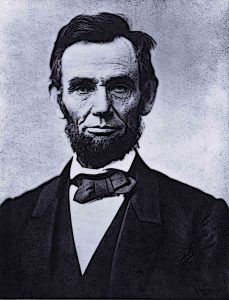
Abraham Lincoln President of United States of America
1861 – Confederate States of American break away from the Union
By 1861, a number of states had broken away from the Union. These states then joined together to become the Confederates States of America. Initially, the Confederacy comprised of 7 states. These included Mississippi, Alabama, Florida, South Carolina, Georgia, Louisiana and Texas. Later the same year, four more states joined the confederacy. These included North Carolina, Arkansas, Virginia and Tennessee.
1861 – American Civil War begins
The difference between the slave and free states deepened. By 1861, the free states were at one side and known as the Union. At the other side were the slave states which were known as the Confederacy. War began between the two sides on April 12, 1861. This war would be one of the bloodiest wars in America.
1861 – First Battle of Bull Run is fought
The First Battle of Bull Run was the first major battle in the American Civil War. It was fought in July, 1861. Nearly 35,000 Union troops fought with 20,000 Confederate soldiers. The Confederate army was able to defeat the Union troops who retreated back to Washington D.C. The battle was fought near a small river called the Bull Run.
1862 – The Homestead Act is passed
In 1862, the Homestead Act was passed by the US government. This act said that any American citizen can go into the western territories and claim up to 160 acres of land if he can settle on the land and farm it for at least 5 years. Within the next few years, 15,000 people had gone into the west and established their claims.
1863 – Battle of Gettysburg takes place
The American Civil War raged on in 1863. The Confederate army under General Robert E. Lee had just secured a major victory. This army ran into the Union's Army of the Potomac on its way to Pennsylvania.
This resulted in the Battle of Gettysburg. The battle was hard fought and both sides suffered heavy losses. The Union army suffered around 23,000 casualties while the Confederates suffered around 25,000 casualties. The Confederates failed to break through the lines of the Union army and had to retreat, resulting in a Union victory.
1863 – Abraham Lincoln delivers the Gettysburg Address
A few months after the Battle of Gettysburg, a dedication ceremony was held in honor of the soldiers who fought at the battle. At this ceremony, President Abraham Lincoln delivered the Gettysburg Address which has since become the best-known speech in the history of USA.
In this speech, Lincoln spoke about the principles of equality and humanity. He also use the famous phrases – the government of the people, by the people, for the people, shall not perish from the earth.
1864 – Sherman's March to the Sea takes place
In 1864, the Confederate stronghold of Atlanta was captured by Union forces under General Sherman. Sherman then took the Union army on a march from Atlanta to Savannah, Georgia. This was a 285 mile march and during the march, the Union army burned crops, fields, barns and factories in their path. This was meant to devastate the economy of the south and force the Confederacy to end the war.
1865 – Civil War Ends
By April, 1865, most of the Confederate armies had been decisively defeated. General Robert E. Lee still commanded one of the last major Confederate armies. This army was completely surrounded by the Union army under Ulysses S. Grant on April 9, 1865. Lee saw that he had no choice and surrendered his army. This effectively brought the Civil War to an end with the victory of the Union forces.
1865 – President Abraham Lincoln is assassinated
On April 9, 1965, the last major Confederate army surrendered. This meant a victory for the Union under the leadership of the President Abraham Lincoln. Only 5 days later, the President was assassinated by John Wilkes Booth who sympathized with the Confederacy. Booth assassinated Abraham Lincoln at Ford's Theatre in Washington D.C. He then fled but was later cornered in a barn and shot by a Union soldier.
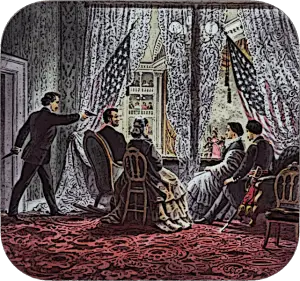
Lincoln Assassination
1865 – Slavery is outlawed in USA
In December, 1865, the US Congress passed the Thirteen Amendment. This amendment made slavery illegal in all the territories of USA as well as the territories where US would have jurisdiction. The text of the amendment stated, 'Neither slavery nor involuntary servitude, except as a punishment for a crime whereof the party shall have been duly convicted, shall exist within the United States, or any place subject to their jurisdiction'.
1867 – USA purchases Alaska from Russia
In the first half of the 19th century, Alaska had a very small population. Russia had an interest in the region. Russian explorers and settlers had arrived at Alaska and although they found natural resources in the region, they couldn't expand their settlements.
On the other side, USA also had its eyes on Alaska and wanted to add the region to the US borders. So in 1867, the two sides reached a deal. USA paid Russia a sum of $7.2 million and effectively became the owner of the Alaska region.
1871 – Great Chicago Fire breaks out
The Great Chicago Fire was a very destructive fire that consumed a large part of Chicago in 1871. The fire broke out on October 8, 1871 and raged for two days.
It caused the destruction of more than 17,000 buildings, causing more than 100,000 people to become homeless. Nearly 300 people were also killed by the fire. In total, the Great Chicago Fire destroyed a 2000-acre area and is considered one of the most devastating fires in the history of US cities.
1872 – USA establishes the first National Park at Yellowstone
In 1872, US Congress passed a bill which established the Yellowstone National Park. President Ulysses S. Grant ratified The Act of Dedication to this effect. Yellowstone became the first National Park of United States and a landmark even in the preservation of natural beauty and resources in the west.
1876 – Battle of Little Bighorn takes place
The Battle of Little Bighorn took place in June, 1876. At the time, the Lakota and Sioux warriors were fighting against the U.S. army. They wanted to stop the white settlers from occupying their lands. On the other hand, U.S. army wanted to remove them from their lands. To end their resistance, Lieutenant Colonel George Armstrong Custer led a small army of U.S. soldiers to confront the Native Americans warriors.
The resulting battle took place near Little Bighorn River in Montana. Custer's forces were routed by the Native Americans. They famously defended themselves as Custer's Last Stand but ultimately, most of the troops were killed. This became one of the most iconic victories of the Native Indian tribes.
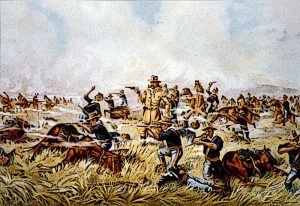
General Custer Massacre At Little Big Horn Montana June 1876
1881 – President Garfield is assassinated
In early 1881, James A. Garfield was elected the President of the United States. A few months later, he was assassinated by Charles Guiteau. Guiteau wanted the President to give up an official position. When Garfield's office administration refused to comply, Guiteau became angry.
He stalked the President. On July 2, he shot President Garfield at the Baltimore and Potomac Railroad station. Garfield didn't die immediately but survived for another 80 days. He eventually succumbed to his wounds and died on September 19. Guiteau was hung for his crime.
1890 – Wounded Knee Massacre takes place
In the late 19th century, a spiritual revival movement took place among the Native American tribes. The Lakota Sioux, in particular, practiced what was popularly known as the Ghost Dance. U.S. government feared this movement may cause the Native Indians to fight the U.S. army. So they decided to surround the Lakota Sioux warriors and demand that they surrender their weapons.
In December, 1890, the 7th Cavalry of the U.S. Army surrounded a village where many prominent Sioux leaders were present. Also present were a large number of women and children.
Just as the Indians were surrendering their weapons, an accidental shot was fired. This led to a violent massacre which saw the deaths of nearly 150 women and children. Most of the villagers were killed. This tragedy became known as the Wounded Knee Massacre.
1898 – USS Maine explodes in Havana harbor
In 1898, USS Maine was sent to Cuba. At the time, the Cubans had revolted against Spanish colonial rule. Maine was sent to possibly rescue the Americans in Havana. While in Havana Harbor, the ship exploded and killed nearly 260 American crew members on board.
This caused widespread shock and anger in USA. Although it wasn't clear what caused the explosion, most Americans blamed Spain. This eventually led to the outbreak of the Spanish-American War later in the year. The war resulted in a decisive American victory.
1899 – Philippine-American War begins
Philippines had long been a colony of Spain before 1898. After Spain was defeated in the Spanish-American War of 1898, it gave up Philippines to USA. At the same time, Philippines declared independence and established the First Philippine Republic.
The US government refused to acknowledge this government and launched a military offensive in Philippines. This became known as the Philippine-American War.
1900 – President William McKinley and Vice President Theodore Roosevelt make government
In 1900, the 29th U.S. presidential elections took place. William McKinley was elected as the 25th President of the United States. Roosevelt became his Vice President.
However, McKinley was assassinated shortly thereafter. This led to the succession of Roosevelt to the Presidency. Roosevelt proved an important figure in American politics and took many important political decisions during his term.
hollinworthkone1963.blogspot.com
Source: https://american-history.net/american-history-timeline/american-history-timeline-1800-1900/